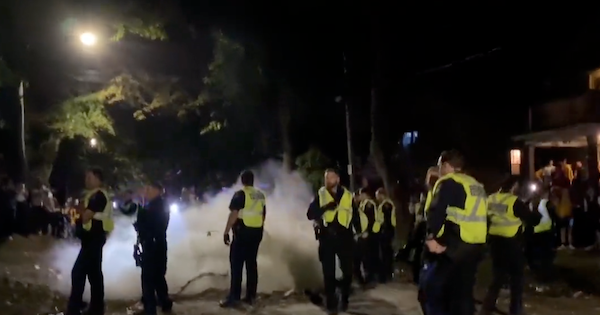Editor’s note:
The Halifax Examiner began publication in June 2014 — more than eight years ago. Over those eight years, we’ve had a very low basic monthly subscription price of $10, and yet have been able to grow the operation to now include a staff of six full-time employees plus regular freelancers.
But it’s time to raise prices. Our employees and freelancers deserve better pay and better supports; and we’d like to expand coverage and hire a new reporter. We want, as they say, to serve you better.
To that end, when our new website comes online later this month, we will raise the basic subscription price to $12/month, with similar increases for other subscription levels — for example, the cost of an annual subscription will rise from $100 to $120.
However, before the new prices take effect, we have a special offer. Existing subscribers can “lock in” the existing annual subscription price of $100, if they renew their annual subscription or upgrade their monthly subscription to an annual subscription before Oct. 15. To take advantage of this opportunity, go here. New subscribers can also lock in the $100 annual subscription rate by going here and clicking on subscription option #6.
We recognize this is a tight economy, and we’ve put off increasing rates for as long as we could. We thank you for your continued support.
News
1. Post-Fiona cleanup
The online application forms to receive Fiona relief funding from the provincial government are now available, here.
The application for $100 for food spoilage for those households that were without power for 48 hours is not difficult — it is not tied to insurance, and there is no need to show proof or provide documentation just sign the affidavit (but if you lie, there could be consequences), here.
The up-to-$250 for tree removal is likewise not onerous, but you have to keep your receipts; apply here.
The $150 to people receiving income assistance will be processed automatically; there is no need to apply.
Seniors already receiving the Seniors Care Grant, can get an additional $250 (up to $500 per household), plus a one-time Home Heating Grant of $250. Apply here.
Residential property owners and tenants can apply for up to $200,000 in uninsured damages. You will need insurance information and other documentation. Apply here.
People can also find the same application forms at MLA offices.
Meanwhile, thousands of residents along the north shore and inland remain without power 10 days after the storm hit. As Jennifer Henderson reported on Thursday, Premier Tim Houston is asking for more military troops to be brought in to help with the cleanup.
 Damage from tropical storm Fiona on a rural road in Malagash Point, NS. Photo: Mary Weckman
Damage from tropical storm Fiona on a rural road in Malagash Point, NS. Photo: Mary Weckman
 The roof of another cottage sits on top of this cottage along the Brule Point Road in Tatamagouche, NS. Photo: Jennifer Henderson
The roof of another cottage sits on top of this cottage along the Brule Point Road in Tatamagouche, NS. Photo: Jennifer Henderson
Joan Baxter, who lives in the area, says there’s extensive damage in her immediate area, with dozens of trees across her road alone and no sign of Nova Scotia Power crews. Some locals cleared enough of the trees from the roadway such that Joan can drive to the Tatamagouche Library to use its wifi and charge devices, but otherwise she remains disconnected from the world. We’ve been able to communicate occasionally via text message, but even that is spotty.
Likewise, the City of Charlottetown appears to still have extensive power losses, with various reception centres and the Confederation Court Mall opened so people can charge devices and such.
You can see the counter-clockwise path of destruction of the storm, as the highest winds came ashore from the southeast on the Louisbourg–Glace Bay stretch of shore, and then again from the northwest down the Northumberland Strait towards Tatamagouche.
About the telecoms…
“It was not a good public relations moment for Canada’s telecommunications companies,” writes Stephen Kimber:
In the US, [Harold Feld, a senior vice-president at Public Knowledge] told the CBC new technologies — including ‘Cell on Light Truck (COLTs),” portable cellular towers that can be deployed where they’re needed when regular towers get knocked out of service, satellite portable units that can connect to a network via a satellite and even flying systems attached to drones — have been created in response to findings by the FCC and the pressure that follows for action.
“There’s a feedback loop that encourages industry to invest in these technologies and safeguards,” Feld said, “but they don’t happen unless the FCC pushes them.”
The FCC has also set up a system requiring wireless companies to send information to the regulator about outages on a county-by-county basis and then shares that publicly on its own network.
The CRTC? Not so much.
Click here to read “Waiting for your telco to really fix what ails our telecommunications system?”
This article is for subscribers. Click here to subscribe.
(Copy link for this item)
2. “Endemic” means “no one much cares anymore”
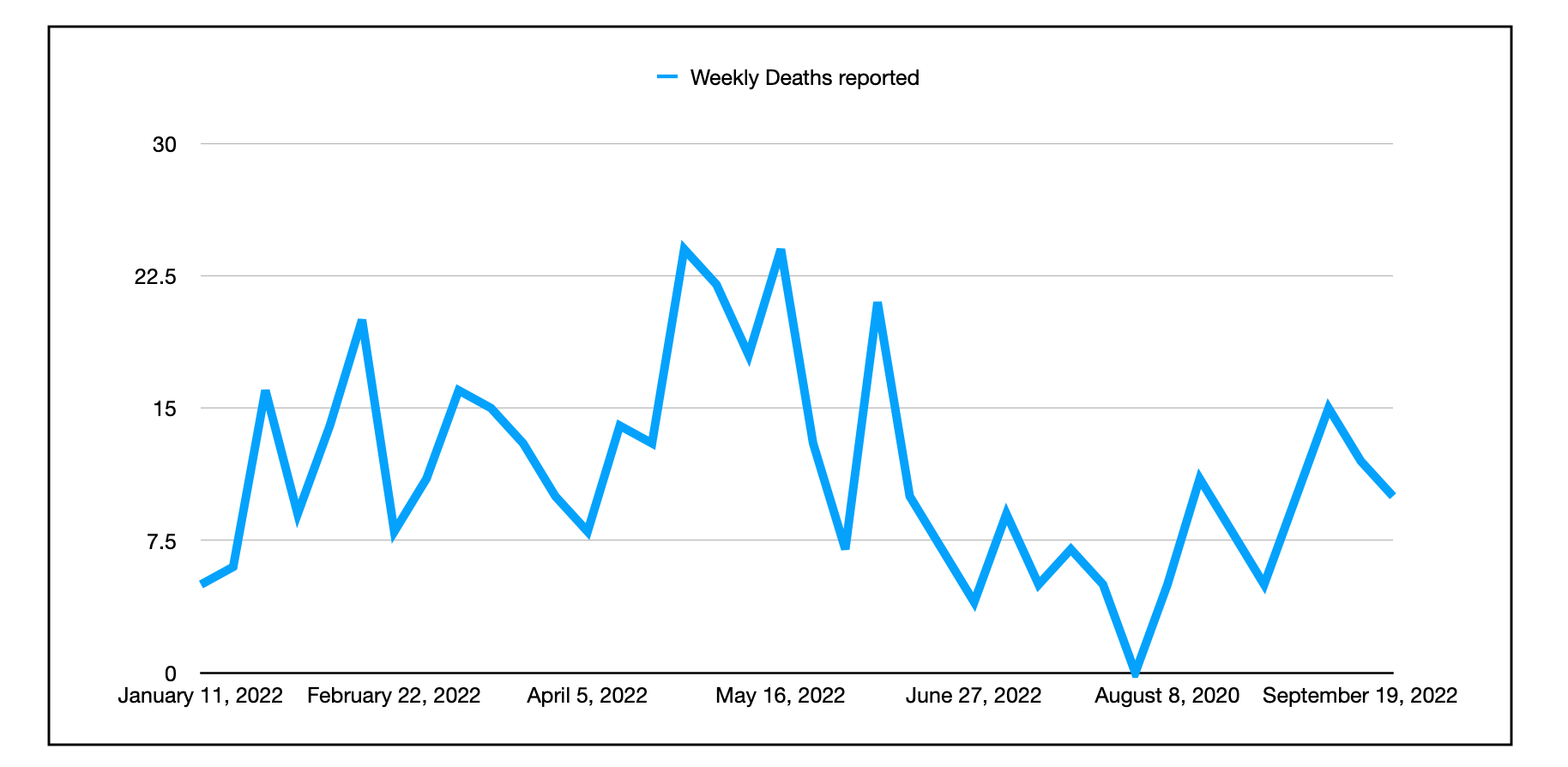 The weekly COVID death count since January 2022.
The weekly COVID death count since January 2022.
Nova Scotia reported 10 new deaths from COVID over the most recent reporting week, Sept. 20-26. Through the pandemic, 544 Nova Scotians have died from COVID, 432 of whom are considered Omicron deaths (since Dec. 8, 2021).
The age and vaccination status of those who have died from COVID in September will be reported in the monthly epidemiological summary, which will be released on Oct. 15.
Additionally, during the Sept. 20-26 reporting period, 56 people were hospitalized because of COVID.
Nova Scotia Health reported the COVID hospitalization status as of Thursday:
• in hospital for COVID-19: 50 (11 of whom are in ICU)
• in hospital for something else but have COVID-19: 138
• in hospital who contracted COVID-19 after admission to hospital: 104
These figures do not include any (if any) children hospitalized at the IWK. Eleven people in ICU is a recent high.
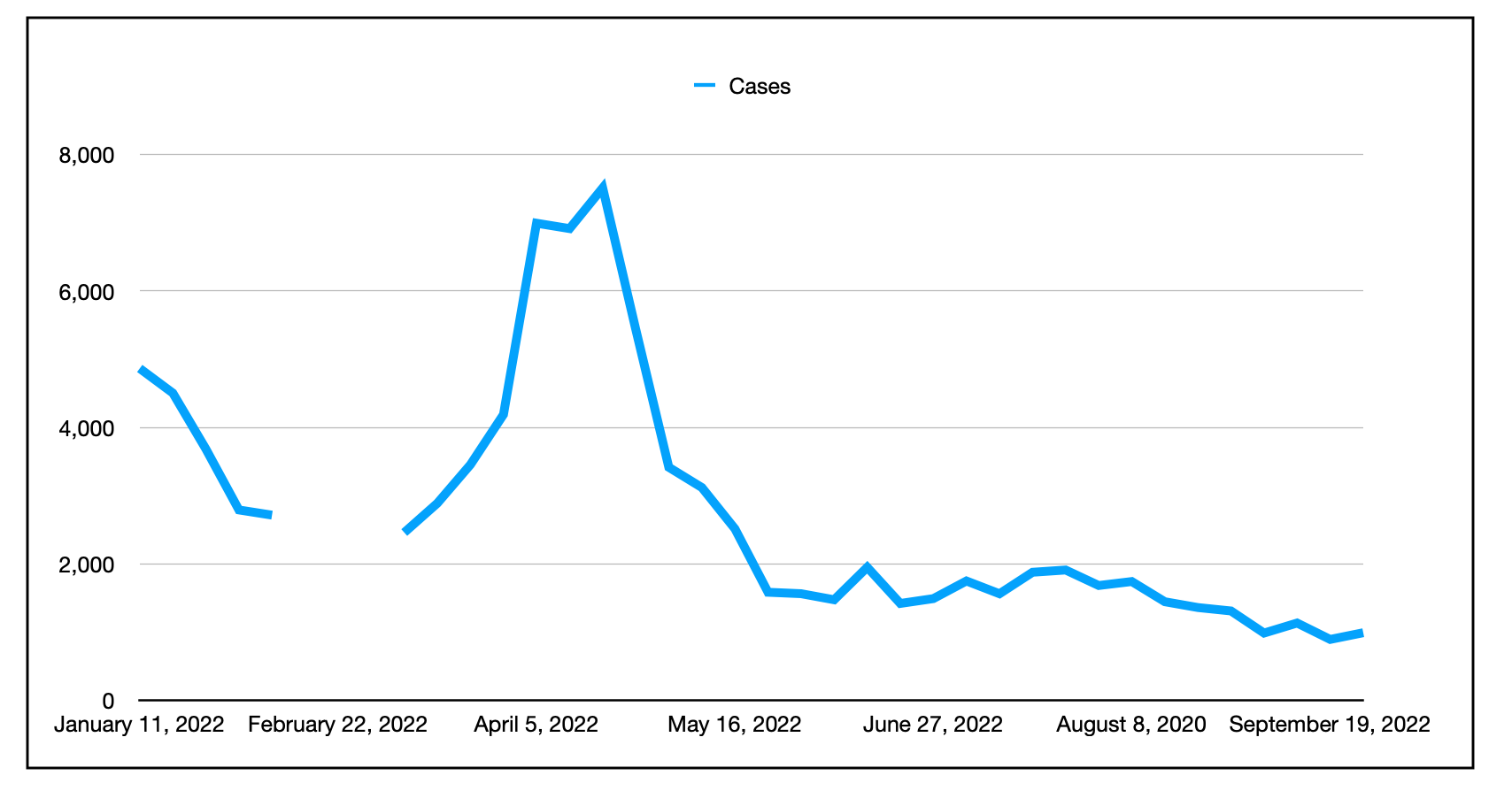 The weekly new case count since January 2022. The gap reflects a temporary change in testing protocol that makes weekly comparison meaningless.
The weekly new case count since January 2022. The gap reflects a temporary change in testing protocol that makes weekly comparison meaningless.
Also for the Sept. 20-26 reporting period, there were 991 lab-confirmed (PCR tests) new cases. This does not include those who tested positive only with the rapid take-home tests, or who didn’t test at all.
(Copy link for this item)
3. Electric ferries
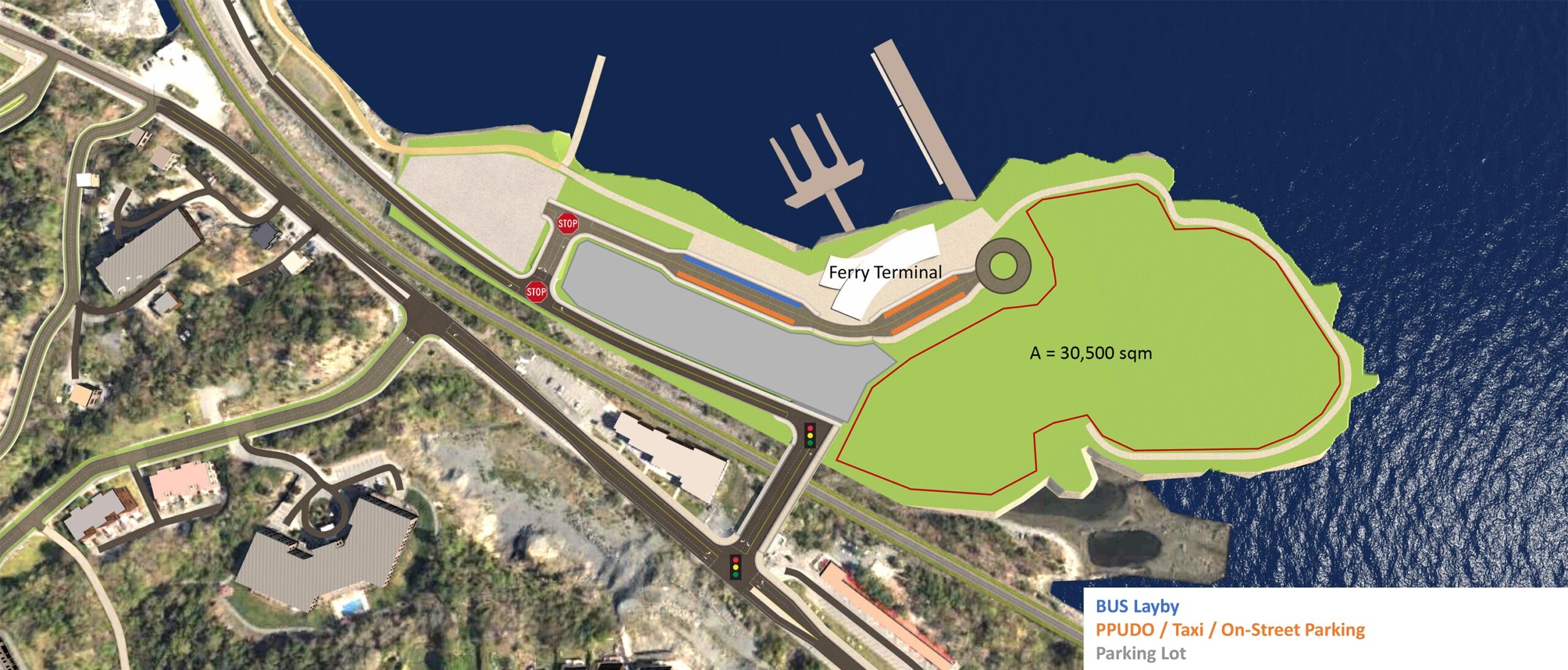 An overhead view of the planned Mill Cove ferry terminal property in Bedford. — Screenshot/HRM
An overhead view of the planned Mill Cove ferry terminal property in Bedford. — Screenshot/HRM
“Councillors have voted in support of a staff-recommended electric ferry service from Bedford with new terminals in Mill Cove and Halifax, a $5 fare, and 20-minute frequency at an estimated cost of $215 million,” reports Zane Woodford:
But whether it ever sets sail depends on funding from the other levels of government.
The plan came to council as part of the Rapid Transit Strategy (RTS), the municipality’s big plan for bus rapid transit, in 2020. The RTS included three new diesel-powered ferry routes from Mill Cove, Larry Uteck Boulevard, and Shannon Park.
Back then, the cost of the Mill Cove ferry service was estimated at $120 million, and the municipality used that figure to ask the federal and provincial governments to pitch in. HRM received funding to further study the idea, and when it looked closer, the price went way up.
The service, as originally conceived, would now cost $288 million, Patricia Hughes, Halifax Transit director of planning and customer engagement, wrote in a report to council on Thursday. While the original estimate was for diesel-powered ferries, staff are now looking at electric vessels.
Click here to read “Halifax to apply for federal funding for electric Bedford ferry service, now estimated at $215 million.”
This article is for subscribers. Click here to subscribe.
Hughes made clear that the electric fleet only constitutes $35 million of the $168 million increase in projected costs, and that the electric boats will have much lower operating costs than a diesel fleet would (the rest of Halifax Transit’s fleet is diesel).
The bulk of the increase in projected costs from the study conducted just two years ago is for costs that were missed, including “mobilization, demobilization, pre-construction management, temporary facilities, demolition, and additional site preparation.” This makes me wonder just how reliable even the new costing estimate is.
The Bedford ferry isn’t quite a megaproject, which is typically defined as a project costing over a billion dollars; the Bedford ferry is more along the scale of the convention centre. But when projects get to this size, expect big cost escalations. I suppose it’s better that at least some of those estimations were discovered before the project began, but it will not surprise me to see the actual cost double or quadruple.
Still, Coun. Waye Mason is right: “We need to accept that if we’re gonna be three quarters of a million people in a couple of decades, we need to lay the foundation now with projects like this.”
My quibble with the proposal is that the Mill Cove terminus sounds a heck of a lot like the Alderney Landing terminal, with an adjacent Park & Ride, offices Halifax Regional Fire and Emergency, and a library. But not once square inch of residential use.
As we build an extensive transit network — including ferries, dedicated bus lanes, and light rail — we should be encouraging residential development around the terminals, so that people can simply walk to the terminal for their commute.
I’m hearing rumours that there’s a plan in the works to tear down the Dartmouth Shopping Centre across the street from the Bridge Terminal and replace it with several residential towers that include ground floor retail. This is much needed — the 1960s era shopping centre and its sprawling parking lot make no sense so close to such an important transit terminal, just a skip away from both downtowns.
The other existing terminals are a mixed bag. Highfield Park is the best in this regard, being within a short walk from many apartment buildings. Lacewood is not as good as Highfield, but still within walking distance for a lot of people. Portland is adjacent to typical suburban sprawl, which is good for the handful of Portland Estates residents who use the bus, but not much otherwise. In Sackville, people are getting killed crossing the highway to get from the trailer park to the transit terminal, which sadly demonstrates the necessity of placing terminals near people’s homes, but surely there must be a better way.
When building new terminals, we should encourage dense residential development in the immediate surrounding area. Undoubtedly, Mill Cove would be a desirable location for apartment dwellers, who would be a short walk to the Mill Cove shopping district and have both fantastic views over the Bedford Basin and easy access to transit. But as proposed, the only people who will use the terminal are those who drive there. This makes no sense.
(Copy link for this item)
4. Guide dogs
 Milena Khazanavicius and her guide dog, Louis. Photo: Contributed
Milena Khazanavicius and her guide dog, Louis. Photo: Contributed
“Three Nova Scotian women who are blind say they face questioning and have been denied entry to restaurants and stores because they use guide dogs,” reports Suzanne Rent.
Here’s one such instance in the article:
On Thursday, Sept. 15, Milena Khazanavicius and Kim Cusack were waiting for a table at Modern Orchid, a restaurant in Dartmouth Crossing, when they say the server told them they couldn’t dine in because of their guide dogs. Khazanavicius has a German Shepherd named Louis that was trained at The Seeing Eye Inc., a guide dog school in Morristown, New Jersey, while Cusack’s dog is a Black Labrador named Georgia that was trained at Canadian Guide Dogs for the Blind in Manotick, ONT.
Cusack was visiting the city from Cape Breton and wanted to check out all her favourite spots, including the Modern Orchid. Khazanavicius and Cusack were joined on the outing by Cusack’s cousin, who is sighted. Cusack said they didn’t get far past the door when an employee stopped them and said no dogs were permitted inside.
“It was clear she knew nothing related to the law about guide dogs,” Cusack said. “I do have a bit of vision, so I could see she kept shaking her head to say, ‘No, you can’t come in here.’”
Khazanavicius, meanwhile, pointed to her own prosthetic eyes, and told the server she is blind.
“At this point, my voice is a little raised because to me, with all the barriers we face on a daily basis, I just wanted to go in and eat with a friend of mine because she liked to order from here,” Khazanavicius said, adding she and Cusack asked to speak with the manager.
Cusack said she feels there may have been a language barrier, because she kept explaining it was the law that she and Khazanavicius be allowed inside the restaurant. The staff person called a manager, who Cusack said also denied them entry to the restaurant.
“I said, again, it’s the law, and if you don’t let us in, I’m going to have to call police,” Cusack said.
Cusack and Khazanavicius said a customer in the restaurant told them there was no such law about guide dogs and they should just go eat somewhere else.
“I couldn’t believe it,” Cusack said. “I am in a restaurant with two people who don’t know the law? It was shocking to me.”
They said the patron interrupted again.
“I said, ‘Let me tell you something. This is a federal and provincial law,” Khazanavicius said she told the customer. “I worked on the [provincial] legislation. If this restaurant refuses us entrance, they will have to pay a hefty fine to Kim and myself.”
Khazanavicius said the customer repeated that no such law existed.
Cusack did call police. Someone representing Modern Orchid wouldn’t speak with Rent about the incident, but directed her to Halifax police. A spokesperson for the police said an officer responded and the issue was resolved without charges.
Click here to read “Blind, partially sighted Nova Scotians say they’re being denied access to spaces because of their guide dogs.”
It’s astonishing that people working retail, and even a manager, don’t know the law.
Khazanavicius told Rent that the 2021 pandemic-response law that allows dogs on patios has led to further confusion, as restaurant staff direct people using guide dogs to go to another restaurant that has a patio.
For myself, I’m indifferent to dogs. Don’t love ’em, don’t hate ’em. However, I was annoyed recently when I was at a patio and a dog was nosing around my food, its owner laughing at the situation — but that’s on the owner, not the dog. Certainly professionally trained guide dogs don’t behave in such ways, and they have every right to work in all public spaces.
(Copy link for this item)
5. Orrell
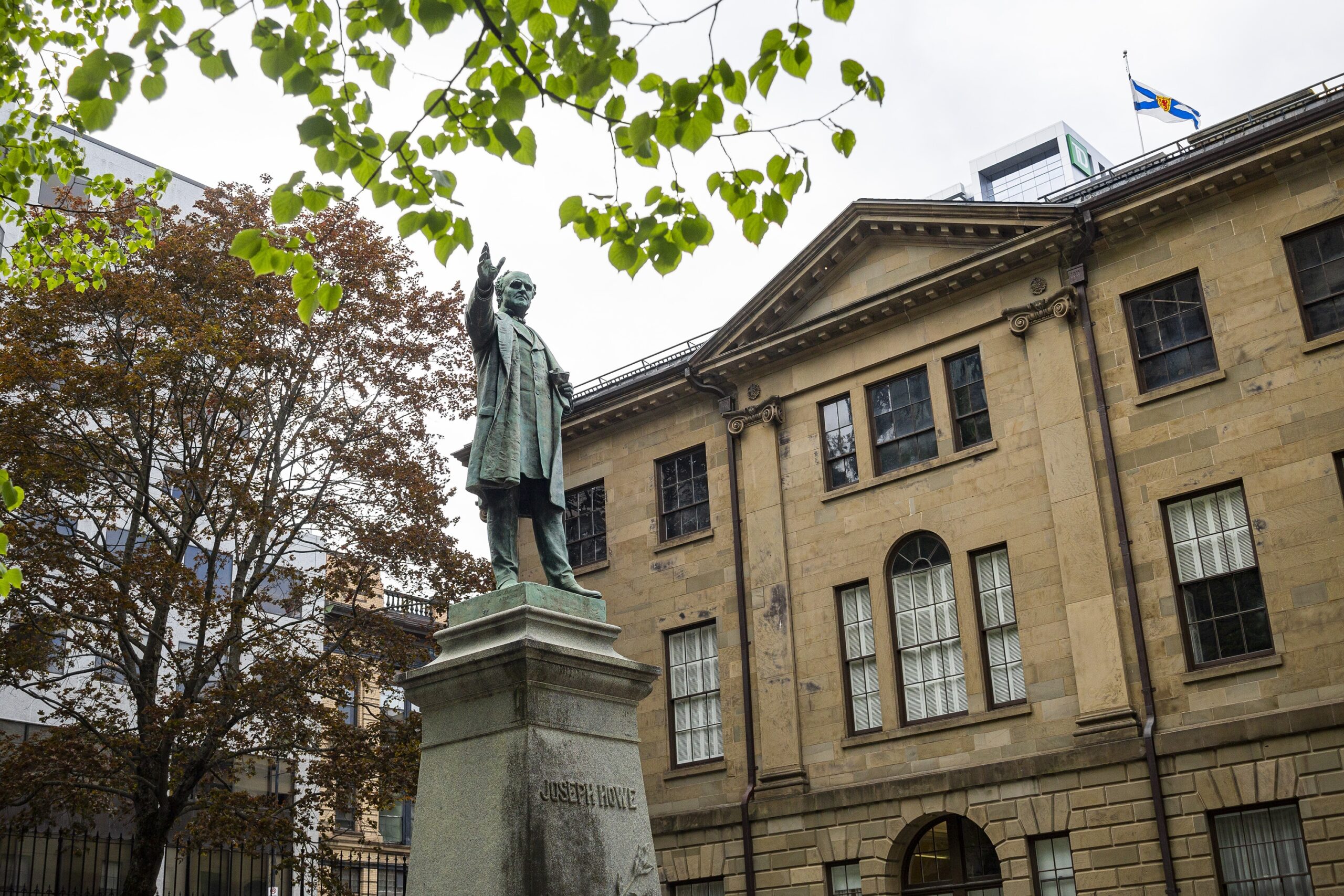 The statue of Joseph Howe outside Province House in June 2021. — Photo: Zane Woodford
The statue of Joseph Howe outside Province House in June 2021. — Photo: Zane Woodford
This item is written by Jennifer Henderson.
The premier and cabinet ministers met last Thursday and took questions from journalists following that meeting, the first in three weeks.
As reported earlier in the Halifax Examiner and other media, the veteran orthoepic surgeon appointed by Premier Tim Houston a year ago to lead a newly created Office of Healthcare Professionals Recruitment left that job sometime in mid-July. Two weeks ago, the government announced Dr. Kevin Orrell had surfaced as a personal advisor to David Dingwall, the president of Cape Breton University, tasked with expanding health education programs at CBU.
When asked, journalists were told Orrell would continue to receive his $350,000 a year salary, which would be split between CBU and the provincial government.
Meanwhile, the job of recruiting doctors, nurses, paramedics, and various other personnel in scarce supply has been delegated to two senior civil servants in addition to their other responsibilities. Dr. Nicole Boutilier, the vice-president of Medicine at Nova Scotia Health (the agency that operates the hospitals), and Craig Beaton, the associate deputy minister in the Department of Health, have been teamed to run the health care recruitment office.
The Houston Conservatives, which ran on a platform to “fix health care” and improve transparency, is struggling to deliver on either. On Thursday, journalists asked Houston why there was a news vacuum for two months surrounding the circumstances of Orrell’s departure from a high-profile job of importance to the province.
“With human resources issues, there are many moving parts,” replied Houston. “You want to make sure things are finalized before you start talking about someone’s career. Dr. Orrell remains an active part of our health leadership team. There are opportunities at Cape Breton University to advance a medical school; I think CBU will benefit from Dr. Orrell’s wisdom.”
Houston went on to say he is “personally interested” in the idea of a medical school in Cape Breton. It may or may not be affiliated with Dalhousie University. Right now, that idea is being explored in part through a $5 million boost from the province last March. Orrell — who lives in the Sydney area — has not responded to our request for an interview. It’s possible he may have been headhunted by CBU to take on a role closer to home and the province was left scrambling to find a face-saving measure.
Two weeks ago, the province announced Orrell’s new job in the same news release that announced the departure of former deputy education minister Cathy Montreuil. Montreuil was let go after eight years and is receiving $227,289 in severance. Asked why Montreuil was dismissed, Education Minister Becky Druhan’s reply was vague and opaque.
“Leadership changes happen within government,” Druhan said. “She did incredible work on our inclusive education policy. I won’t speak to human resource issues”.
For now, that’s all we know.
(Copy link for this item)
6. The Tideline, Episode 96: The End

After two years and 95 episodes The Tideline is washing up but one last time. It’s a bit of a format flip, featuring first guest and perennial mention Kat McCormack in the host chair, talking to Tara about the history of arts coverage in Halifax, the dire straits of the local music venue, the disconnection of the disciplines, and some fun stuff too! Thanks to the team at the Halifax Examiner and engineer/mixer Palmer Jamieson for a fine little podcast. And especially thanks to you for listening.
Click here to listen to the show.
(Copy link for this item)
Noticed
Saturday, I took the #1 bus over to the peninsula. When I got off the bus on Coburg Road at around 2pm, there were groups of students, hundreds and hundreds of them, wearing Dal shirts and facepaint and the like, roaming around, seemingly in search of parties. It was Homecoming.
Given that there were large party weekends even during the pandemic lockdowns, I had no doubt there would be similar, but larger, blowouts Saturday night. And sure enough, this was the situation on Larch Street:
The situation pic.twitter.com/hGu1RaZSaR
— Abdiel 🐝☕️ (@abbydealer) October 2, 2022
Sunday morning, Halifax police described the situation as follows:
Last night at approximately 10 p.m. large crowds of intoxicated people started to gather in the areas of Larch, Preston and Jennings Streets. The crowd estimated at approximately 3,000 to 4,000 people extended out to Preston Street and Jubilee Road. Participants were climbing poles and trees and fireworks were being set off in the crowd and in some cases directed towards residences. Disturbances and fights were occurring within the large crowd.
While police were on scene throughout the day and into the evening, additional resources were deployed from patrol divisions across the city as the size of the gathering increased. Officers attempted to disperse the crowd and were met with a high level of resistance. Bottles, cans and debris from the storm were thrown at officers. Along with being hit with projectiles, officers were punched, kicked and spit on. Some officers required treatment for non-life-threatening injuries.
A fire was set in the street using downed branches from the storm in an attempt to prevent officers from dispersing the crowd. Officers were required to put the fire out as Halifax Regional Fire and Emergency could not get in due to safety concerns.
Officers had to bring a number of injured people out of the area, including a man who suffered injuries as a result of being stabbed, as Emergency Health Services could not get to the injured person due to the crowds and safety hazards.
After a couple of hours officers were able to disperse the crowd. A number arrests were made, and dozens of summary offence tickets were issued.
Saturday night, Aparna Mohan, the president of the Dal Student Union, had a different take on the police action.
Wrote Mohan, in a series of tweets:
I’m breathing deep sighs after what I witnessed happen at #dalhoco tonight. Students texted me saying @HfxRegPolice had begun to pepper spray, tear gas & jump partygoers at Larch Street tonight and I was sent the following video of one such apprehension. (1/8) pic.twitter.com/yhl5ZTAzV8
— Aparna Mohan (@aparnadsupres) October 2, 2022
I’m breathing deep sighs after what I witnessed happen at #dalhoco tonight. Students texted me saying @HfxRegPolice had begun to pepper spray, tear gas & jump partygoers at Larch Street tonight and I was sent the following video of one such apprehension. (1/8)
I’m still collecting my thoughts about everything I heard and saw but no matter how noisy, how obnoxiously drunk students get, the use of such violence is unjustified and speaks to the values (or lack thereof) of a service that purportedly protects the community (2/8)
It wasn’t even targeted. The police did rounds walking down the street every 15 minutes with tear gas & pepper spray hoping to clear the streets of students that were mostly just standing around looking for the next spectacle. The police gave them plenty (3/8)
Similar sized street parties took place in at least 4 other university communities across Canada today. This issue is clearly larger than @DalhousieU but other stakeholders with decision making power have not engaged proactively and have chosen to remain reactionary (4/8)
This includes the recent @hfxgov bylaw amendment to restrict business hours for corner stores in residential neighborhoods which was a clear reaction to one community with little to no attention to broader implications & harms (5/8)
@DalStudentUnion gratefully engaged in conversations that informed key recommendations from the Dal-led consultation over the summer. We didn’t receive the necessary funding to action our proposed outdoor concert but we supported on-campus harm reduction efforts instead (6/8)
HRP & HRM council did not despite invitations to. It’s hard to engage in proactive planning when there is a frankly terrifying amount of anti-student sentiment in this city & continued reliance on policing to address community concerns (7/8)
I do not, for a second, condone the disruption and disrespect I witnessed from many partygoers tonight but I cannot condone violence as a reasonable, proportionate response. We can and must do better. (8/8)
I can’t say I have much to offer. It probably comes off as glib to some readers, but people have been complaining about university students partying for as long as there have been university students. I don’t say that to discount the real disruption to neighbourhoods and the real public safety risks. Just, as Mohan says, the issues at stake are much larger than Dalhousie.
Heck, I went to Chico State in the 1980s, when Playboy Magazine named it the #1 party school in the United States. Scenes like were experienced in the south end Saturday happened every weekend in Chico, and weekends started on Thursday. This was long before big parties could be blamed on cell phones or Instagram; students just went roaming around and found and formed giant parties. Burning couches in the middle of Fifth Street were regular occurrences, as were bottles thrown at cops. Once, a TV news van appeared on scene to record the mayhem, and it too was set aflame. Early in the mornings, I would walk around the student neighbourhoods north and south of campus and find something like a war zone post-battle, with people passed out on lawns, broken bottles everywhere, an empty keg rolling down the street, and otherwise, eery silence.
Finally, so many students died of alcohol poisoning and so many students were sexually assaulted that there was an overwhelming government and school response, with fraternities de-sanctioned, partiers roughed up by huge police responses, the temporary closure of liquor stores, and more. Chico State is still a party school, but the open chaos is mostly a thing of the past.
In response to Saturday night, some people have suggested that Dalhousie banning alcohol in the dorms and becoming mostly a dry campus (The Grawood, the campus pub, closes at 9pm during the week and is closed completely on Saturdays and Sundays) effectively pushed the problems off-campus. Some have suggested that the university host on-campus parties during Homecoming, keeping the students out of the neighbourhoods and under the watchful eye of security and such.
Perhaps. Maybe on-campus events would take an edge off the mayhem, but I’m doubtful they would have the desired effect: the entire point of the street parties and the mayhem is that it is unsanctioned, youthful rebellion. Only squares go to sanctioned parties.
One person I had an exchange with on Twitter blamed power drinks for part of the problem. She’s not entirely wrong about this — if you’re merely drinking a lot of alcohol, you pass out soon enough and that’s the end of it. But if you’re doing Red Bull and Jager, you’re going to power through and drink even more.
But that’s too simplistic. First, young people are, well, young. They’ve got a tremendous ability to binge drink without much assistance. Secondly, blaming power drinks is ignoring that a substantial number of partiers have an even more effective stay-awake strategy: cocaine. No one much talks about it, but there’s plenty of coke and crack swilling around the party scene, just as much now as back in my college days. (I don’t use coke, and never have, but I guarantee you I could buy some coke by the end of the day, no problem. It’s just so available.)
I hate to admit this, but I have had friends — really good friends, people close to me — die from using coke and alcohol. It catches up with you, eventually. They are the sad leading edge of the problem, but there’s a great bulk of coke-infused partying that goes under the radar.
Again, I don’t have solutions. But I think the heavy-handed police response is exactly the wrong thing to do, both because it is in itself wrong and because it probably won’t work.
Better that some sort of harm-reduction strategy be developed. I recognize that “harm-reduction” is in danger of becoming just another meaningless buzzword, like “sustainable,” “resilient,” and so forth, but before it completely loses meaning, we should take the moment and have some open conversation.
Young people drink. A lot. They binge. They use cocaine and drink. They party in order to fight. They party in hopes of hooking up and having sex. They party as rebellion against societal norms and expectations. And there’s nothing we can do about that.
So now what?
(Copy link for this item)
Government
City
Monday
Transportation Standing Committee (Monday, 1pm, City Hall, and via video) — agenda
District Boundary Resident Review Panel (Monday, 3:30pm, City Hall) — agenda
North West Community Council (Monday, 7pm, Bedford-Hammonds Plains Community Centre) — agenda
Tuesday
Advisory Committee on Accessibility in HRM (Tuesday, 4pm, online) — agenda
Province
Monday
No meetings
Tuesday
Community Services (Tuesday, 10am, One Government Place) — Supportive Housing, with representatives from Dept. of Community Services, Dept. of Municipal Affairs and Housing, Phoenix Youth Programs, and Affordable Housing Association of Nova Scotia
Human Resources (Tuesday, 2pm, One Government Place) — agenda setting, and agency, board, and commission appointments
On campus
Dalhousie
Herzberg50 Exhibit (Monday, 9am, LeMarchant Place) — traveling exhibit, Enterprises of the Human Spirit: 50 Years of Scientific Excellence in Germany and Canada, hosted at LeMarchant Place until Oct 7, Tupper Medical Building Oct 11-14, and Richard Murray Design Building Oct 17-21.
Phd Defence, Engineering Mathematics and Internetworking (Monday, 10am, online) — Koustubh Bindiganavile Sudarshan will defend “Neural Population Dynamics in Porcine Stellate Ganglion in Normal and Heart Failure States”
Saint Mary’s
Monday
Unlocking Community Museum Collections (Monday, 2pm, in the room named after a multinational consumer goods company, in the building named after a supermarket chain) — from the listing:
Many community museums in Nova Scotia contain artefacts associated with Nova Scotia’s four founding cultures: Mi’kmaq, African Nova Scotians, Acadians and Gaels. In many cases, there has been a loss of cultural knowledge and stories associated with the artefacts. This summer, the Association of Nova Scotia Museums (ANSM) began the development of a digitization strategy for these collections, with a focus on making them more accessible through NovaMuse.ca, ANSM’s collections portal. The first step of this work was visiting the cultural communities to hear and understand their needs relating to these collections.
Tuesday
National Day of Action MMIWG2S (Tuesday, 4:30pm, Library Classroom) — with guest speaker Denise Digiosa, and the hanging of red dresses to commemorate Missing and Murdered Indigenous Women, Girls and 2SLGBTQ+ people. More info and RSVP here.
In the harbour
Halifax
06:00: Tropic Lissette, cargo ship, arrives at Pier 41 from Philipsburg, Sint Maarten
07:30: Norwegian Prima, cruise ships with up to 3,95o passengers, arrives at Pier 31 from Reykjavik, Iceland, on a 12-day cruise from Southampton, England to New York
13:30: Lagrafoss, container ship, arrives at Pier 42 from Reykjavik, Iceland
16:00: MSC Aniello, container ship, arrives at Pier 42 from Sines, Portugal
16:30: Norwegian Prima sails for New York
17:00: Atlantic Sky, ro-ro container ship, arrives at Fairview Cove from Antwerp, Belgium
17:30: Star Pride, cruise ship with 254 passengers, arrives at Pier 23 from Bar Harbor, on an 11-day cruise from Boston to Montreal
20:30: Tropic Lissette sails for Portland
23:00: Atlantic Star, container ship, arrives at Fairview Cove from Baltimore
23:45: Lagrafoss sails for Portland
Cape Breton
03:00: CSL Kajika, bulker, sails from Aulds Cove quarry for Boston
03:00: CSL Tarantau, bulker, moves from Pirate Harbour anchorage to Aulds Cove quarry
11:00: Harmonic, oil tanker, sails from EverWind for sea
12:00: MM Newfoundland, barge, and Lois M, tug, sail from Sydport for sea
14:00: Phoenix Admiral, oil tanker, arrives at EverWind from New York
Footnotes
Each day is becoming shorter and colder. At this rate, by June the entire planet will be a dark, frozen, lifeless place.
Subscribe to the Halifax Examiner
We have many other subscription options available, or drop us a donation. Thanks!


